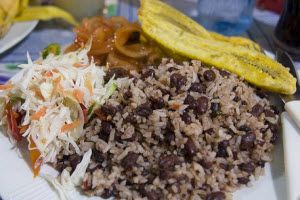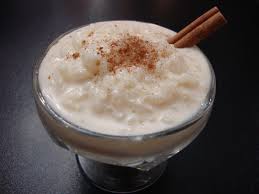The staple dish of Nicaragua is called “Gallo Pinto” or “painted rooster.” Many families (and Peace Corps volunteers) eat it daily and often more than once. It is eaten for all three meals of the day, and it is actually pretty delicious unless it is drowning in oil or salt as tends to happen. It’s very simple and cheap in addition to being a good way to re-use leftovers from other meals, hence the popularity. Give it a try!
Gallo Pinto:
- Cooked red or black beans (Nicas love red beans and only use black beans when they can’t find red beans)
- Vegetable oil
- Cooked rice
Optional:
- Salt
- Bell pepper
- onion
Using a 1 to 1 rice to beans ratio, fry the cooked beans with vegetable oil, and then add the cooked rice. An option is to cook the rice with bell pepper and onions, and add salt to your taste. Serve with tajadas, which are fried plantains, cuajada, a fresh cheese, and a side salad of white cabbage marinated with lime juice, vinegar and salt. YUM!
You’re done! Enjoy!
When I was in training, the family had a 1 year old, and the grandmother would often sing a song that went “Arroz con leche me quiero casar con una senorita de la capitol…..” It was the first song I learned in Spanish, and therefore arroz con leche has a special place in my heart. So here’s another very frequent and easy to make Nicaraguan recipe: Arroz con leche. It’s perfect for the cool nights we have here in San Rafael del Norte.
Arroz con Leche:
- 1 cup of rice
- 3 cups of milk
- Sugar
- Cinnamon sticks
Optional:
- raisins
Boil the rice with a just enough water to cover it in a large pot for about 5 minutes. Later, add the milk and continue stirring until the rice is cooked. Add sugar and cinnamon to your taste while cooking. If you decide to add raisins, just stir them in before serving. Serve warm or at room temperature.
Coming up next: Nacatamales!
Love from Nicaragua,
M x


We’ll have a family Nicaraguan feast when you get home, so keep collecting the recipes! I loved all the la plancha chicken dishes I had in Nicaragua–and the plantains, of course!
Love from your Mom
now I am hungry. lol
My favorite Gallo Pinto recipe
Gallo Pinto
Gallo Pinto – a nutritious concoction of fried rice and boiled beans with some fresh greens thrown into the mix – is a staple food for most people in Nicaragua and it is not uncommon to eat it for breakfast, lunch and dinner, often with slight variations depending on what the family have grown themselves or can afford to buy. When resources allow, pieces of beef or chicken is added or the Gallo Pinto is turned into a side dish rather than constituting a whole meal. In fact, Gallo Pinto is such a quintessential part of Nicaraguan cuisine that you can get Mc Gallo Pinto for your McDonalds breakfast in Managua.
The name Gallo Pinto literary means “painted rooster” or “speckled rooster” in Spanish and is a reference to the look of the dish. Similar dishes can be found in many parts of the Spanish speaking world, e.g. Moros y Cristianos (“Moors and Christians”) in Spain, Casamiento (“Marriage”) in El Salvador, and Tacu tacu in Peru.
A Gallo Pinto can be varied endlessly and those Nicaraguans who like spicy food usually add chopped red peppers of a very small and hot variety. As mentioned above you can also add chopped pieces of meat and virtually any vegetable or fruit that you happen to find in your kitchen or garden. I often include fried plantain (”food banana”) and chayote when serving Gallo Pinto as a main course, and use fresh cilantro sprigs as decoration.
Gallo Pinto is considered the national dish of both Nicaragua and Costa Rica and asking about its true origin – or the proper way of making it – is a sure fire way of starting a hot debate if members of both nationalities are represented at the dinner table.
Ingredients
* 1 lb (450 grams) of fresh red beans. If you can’t find fresh, get dry ones and weigh them after you’ve soaked them. Now, if you ask a Costa Rican they’ll tell you that BLACK beans are the only proper way to do Gallo Pinto, but this is a Nica site so we’re using red ones.
* 10 sprigs of cilantro. Fresh is best, but frozen will work too. Don’t use dried cilantro. In some English speaking countries, cilantro is more commonly referred to as coriander (Coriandrum sativum) so if the shop assistant goes blank when you ask for cilantro try asking for fresh or frozen coriander instead.
* 1 onion
* ½ sweet pepper
* 1 tablespoon of vegetable oil to fry the rice
* 3 cups of chicken broth (if you want to make a veggie dish, use water or vegetable broth)
* 2 cups of white rice
* ½ teaspoon of salt
* 1-3 tablespoons of vegetable oil to fry the Gallo Pinto
Instructions
* If the beans are dried, cover them with water and soak over night to have them ready for your breakfast Gallo Pinto. If they’re fresh, just rinse them off.
* Pour the drained beans into a pot and add fresh water until the surface is about 2.5 cm (1 in) above the top of the beans. If you add salt at this point it will make the bean shells harder; if you wait they will be softer.
* Bring to a boil, cover the pan and reduce heat to a very low simmer. Keep on simmering until the beans are soft and the juice is almost consumed.
* In the mean time, chop cilantro, onion and sweet pepper into very small pieces.
* Pour 1 tablespoon of oil into a large frying pan and heat up.
* Pour the dry, uncooked rice into the frying pan and sauté for two minutes over medium high flame. If you burn the rice it means that you’re using too much heat. Frying raw rice might seem strange to the non-latino, but by frying it raw you prevent it from becoming mushy later on when blended with the beans.
* Add cilantro, sweet pepper and half of the onion to the pan and continue to sauté for another two minutes.
* Add chicken broth and bring to a boil.
* Cover the frying pan and reduce the heat. Leave to simmer until the rice is tender. This will normally take 20-35 minutes.
* Stir in the boiled beans and the other half of the onion.
* Add salt to taste.
* Add the rest of the vegetable oil and fry the Gallo Pinto a few more minutes before serving.
This is quite a time consuming dish, especially the bean boiling part, but you can always make the rice and beans in advance and keep them in the freezer or refrigerator. When storing boiled beans, keep them in their own “black water” since this will add colour and flavour to the dish. In Nicaragua, it is common to have a pot of beans simmering on the stove more or less constantly.
Caribbean style
Along the English speaking Atlantic coast of Nicaragua, this dish is simply known as rice and beans. It is prepared in much the same way as Gallo Pinto, but is fried in coconut oil and/or simmered in coconut milk made from shredded coconuts which gives it a characteristic flavor.
Copyright 2010 – Nicaraguafood.com